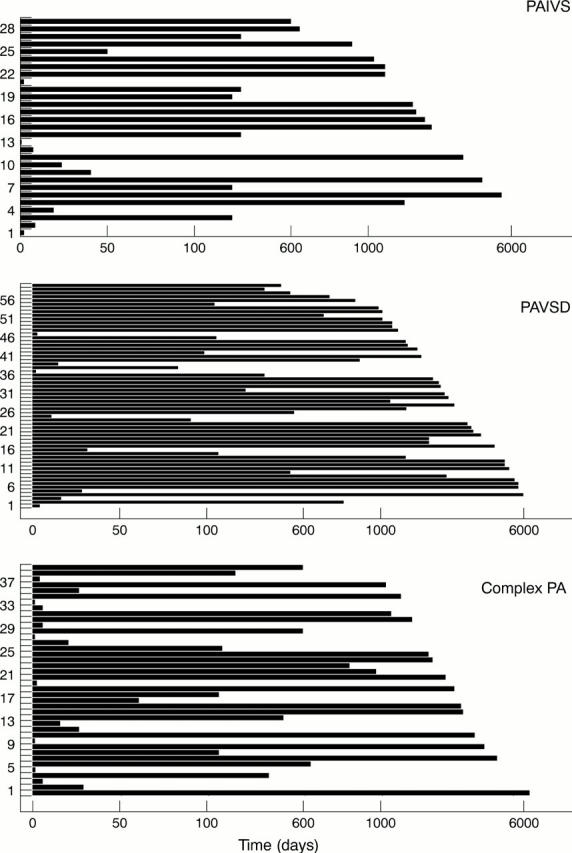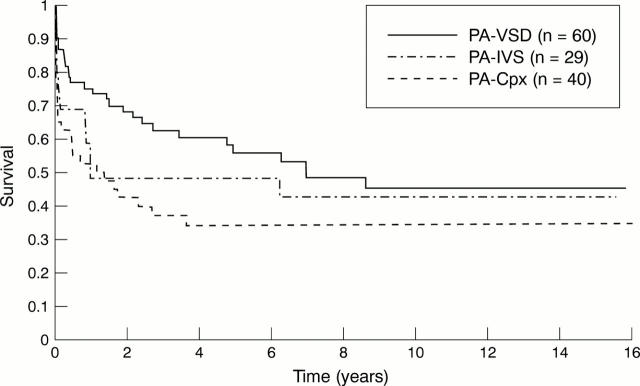Abstract
OBJECTIVE—To investigate mortality, cause of death, survival, and quality of life in all types of cardiac malformation with congenital pulmonary atresia. DESIGN—Retrospective analysis. SETTING—The resident population of one health region with a single tertiary referral centre. PATIENTS—All babies with pulmonary atresia live born in 1980 to 1995. MAIN OUTCOME MEASURES—Anatomical classification, total mortality, cause of death, duration of survival, exercise ability. All cases were classified as pulmonary atresia with intact septum (PA-IVS), pulmonary atresia with ventricular septal defect (PA-VSD), or pulmonary atresia with complex cardiac malformation (complex pulmonary atresia). RESULTS—129 cardiac malformations with congenital pulmonary atresia were identified from 601 635 live births (21.4/100 000): 29 had PA-IVS, 60 had PA-VSD, and 40 had complex pulmonary atresia. Total mortality was 72/129 (56%), with 15 deaths in the first week and 49 in the first year. There were 23 surgical deaths, 33 hospital deaths (not related to surgery), and 16 sudden deaths, 12 of which remained unexplained. The sudden death rate was 29/1000 patient years of follow up. Of the 57 survivors, 39% have exercise ability I or II and 61% III or IV. Definitive surgical repair produced better exercise ability. CONCLUSIONS—Early mortality is high in all types of pulmonary atresia, although survival has improved in recent years. Most children who have not undergone definitive repair have significant exercise limitation. Keywords: congenital heart disease; pulmonary atresia; sudden death; quality of life
Full Text
The Full Text of this article is available as a PDF (126.0 KB).
Figure 1 .

Survival plots for patients in all three groups. The length of the line shows time to follow up or death (in days). Patients are plotted in birth order on the y axis so that lines stopping short of the right hand outline indicate death, while those reaching the right hand outline indicate survival at latest follow up. Note that a three step linear scale is employed, as a logarithmic or linear scale would distort the plot.
Figure 2 .
Kaplan-Meier survival plot for pulmonary atresia with intact septum (PA-IVS), pulmonary atresia with ventricular septal defect (PA-VSD), and complex pulmonary atresia (PA-Cpx).
Selected References
These references are in PubMed. This may not be the complete list of references from this article.
- Bland J. M., Altman D. G. Survival probabilities (the Kaplan-Meier method). BMJ. 1998 Dec 5;317(7172):1572–1572. doi: 10.1136/bmj.317.7172.1572. [DOI] [PMC free article] [PubMed] [Google Scholar]
- Bull K., Somerville J., Ty E., Spiegelhalter D. Presentation and attrition in complex pulmonary atresia. J Am Coll Cardiol. 1995 Feb;25(2):491–499. doi: 10.1016/0735-1097(94)00364-v. [DOI] [PubMed] [Google Scholar]
- Coles J. G., Freedom R. M., Lightfoot N. E., Dasmahapatra H. K., Williams W. G., Trusler G. A., Burrows P. E. Long-term results in neonates with pulmonary atresia and intact ventricular septum. Ann Thorac Surg. 1989 Feb;47(2):213–217. doi: 10.1016/0003-4975(89)90271-3. [DOI] [PubMed] [Google Scholar]
- Daubeney P. E., Sharland G. K., Cook A. C., Keeton B. R., Anderson R. H., Webber S. A. Pulmonary atresia with intact ventricular septum: impact of fetal echocardiography on incidence at birth and postnatal outcome. UK and Eire Collaborative Study of Pulmonary Atresia with Intact Ventricular Septum. Circulation. 1998 Aug 11;98(6):562–566. doi: 10.1161/01.cir.98.6.562. [DOI] [PubMed] [Google Scholar]
- Dinarevic S., Redington A., Rigby M., Shinebourne E. A. Outcome of pulmonary atresia and ventricular septal defect during infancy. Pediatr Cardiol. 1995 Nov-Dec;16(6):276–282. doi: 10.1007/BF00798061. [DOI] [PubMed] [Google Scholar]
- Ferencz C., Rubin J. D., McCarter R. J., Brenner J. I., Neill C. A., Perry L. W., Hepner S. I., Downing J. W. Congenital heart disease: prevalence at livebirth. The Baltimore-Washington Infant Study. Am J Epidemiol. 1985 Jan;121(1):31–36. doi: 10.1093/oxfordjournals.aje.a113979. [DOI] [PubMed] [Google Scholar]
- Hadjo A., Jimenez M., Baudet E., Roques X., Laborde N., Srour S., Surrel C., Choussat A. Review of the long-term course of 52 patients with pulmonary atresia and ventricular septal defect. Anatomical and surgical considerations. Eur Heart J. 1995 Nov;16(11):1668–1674. doi: 10.1093/oxfordjournals.eurheartj.a060793. [DOI] [PubMed] [Google Scholar]
- Hanley F. L., Sade R. M., Blackstone E. H., Kirklin J. W., Freedom R. M., Nanda N. C. Outcomes in neonatal pulmonary atresia with intact ventricular septum. A multiinstitutional study. J Thorac Cardiovasc Surg. 1993 Mar;105(3):406-23, 424-7; discussion 423-4. [PubMed] [Google Scholar]
- Healy M. J. Survival data. Arch Dis Child. 1995 Oct;73(4):374–377. doi: 10.1136/adc.73.4.374. [DOI] [PMC free article] [PubMed] [Google Scholar]
- Hofbeck M., Sunnegårdh J. T., Burrows P. E., Moes C. A., Lightfoot N., Williams W. G., Trusler G. A., Freedom R. M. Analysis of survival in patients with pulmonic valve atresia and ventricular septal defect. Am J Cardiol. 1991 Apr 1;67(8):737–743. doi: 10.1016/0002-9149(91)90532-p. [DOI] [PubMed] [Google Scholar]
- Jahangiri M., Zurakowski D., Bichell D., Mayer J. E., del Nido P. J., Jonas R. A. Improved results with selective management in pulmonary atresia with intact ventricular septum. J Thorac Cardiovasc Surg. 1999 Dec;118(6):1046–1055. doi: 10.1016/S0022-5223(99)70100-5. [DOI] [PubMed] [Google Scholar]
- Leung M. P., Mok C. K., Lee J., Lo R. N., Cheung H., Chiu C. Management evolution of pulmonary atresia and intact ventricular septum. Am J Cardiol. 1993 Jun 1;71(15):1331–1336. doi: 10.1016/0002-9149(93)90550-v. [DOI] [PubMed] [Google Scholar]
- Luciani G. B., Swilley S., Starnes V. A. Pulmonary atresia, intact ventricular septum, and major aortopulmonary collaterals: morphogenetic and surgical implications. J Thorac Cardiovasc Surg. 1995 Sep;110(3):853–854. doi: 10.1016/S0022-5223(95)70121-4. [DOI] [PubMed] [Google Scholar]
- Mair D. D., Julsrud P. R., Puga F. J., Danielson G. K. The Fontan procedure for pulmonary atresia with intact ventricular septum: operative and late results. J Am Coll Cardiol. 1997 May;29(6):1359–1364. doi: 10.1016/s0735-1097(97)00051-x. [DOI] [PubMed] [Google Scholar]
- Miyaji K., Shimada M., Sekiguchi A., Ishizawa A., Isoda T., Tsunemoto M. Pulmonary atresia with intact ventricular septum: long-term results of "one and a half ventricular repair". Ann Thorac Surg. 1995 Dec;60(6):1762–1764. doi: 10.1016/0003-4975(95)00764-4. [DOI] [PubMed] [Google Scholar]
- Najm H. K., Williams W. G., Coles J. G., Rebeyka I. M., Freedom R. M. Pulmonary atresia with intact ventricular septum: results of the Fontan procedure. Ann Thorac Surg. 1997 Mar;63(3):669–675. doi: 10.1016/s0003-4975(96)01366-5. [DOI] [PubMed] [Google Scholar]
- Reddy V. M., McElhinney D. B., Silverman N. H., Marianeschi S. M., Hanley F. L. Partial biventricular repair for complex congenital heart defects: an intermediate option for complicated anatomy or functionally borderline right complex heart. J Thorac Cardiovasc Surg. 1998 Jul;116(1):21–27. doi: 10.1016/S0022-5223(98)70238-7. [DOI] [PubMed] [Google Scholar]
- Rychik J., Levy H., Gaynor J. W., DeCampli W. M., Spray T. L. Outcome after operations for pulmonary atresia with intact ventricular septum. J Thorac Cardiovasc Surg. 1998 Dec;116(6):924–931. doi: 10.1016/S0022-5223(98)70042-X. [DOI] [PubMed] [Google Scholar]
- Silka M. J., Hardy B. G., Menashe V. D., Morris C. D. A population-based prospective evaluation of risk of sudden cardiac death after operation for common congenital heart defects. J Am Coll Cardiol. 1998 Jul;32(1):245–251. doi: 10.1016/s0735-1097(98)00187-9. [DOI] [PubMed] [Google Scholar]
- Wren C., Richmond S., Donaldson L. Presentation of congenital heart disease in infancy: implications for routine examination. Arch Dis Child Fetal Neonatal Ed. 1999 Jan;80(1):F49–F53. doi: 10.1136/fn.80.1.f49. [DOI] [PMC free article] [PubMed] [Google Scholar]
- Wren C., Richmond S., Donaldson L. Temporal variability in birth prevalence of cardiovascular malformations. Heart. 2000 Apr;83(4):414–419. doi: 10.1136/heart.83.4.414. [DOI] [PMC free article] [PubMed] [Google Scholar]



